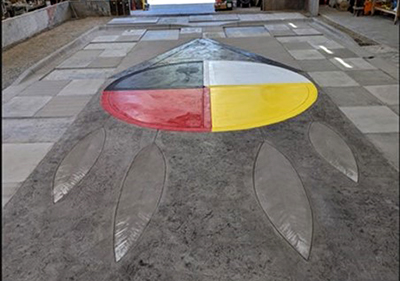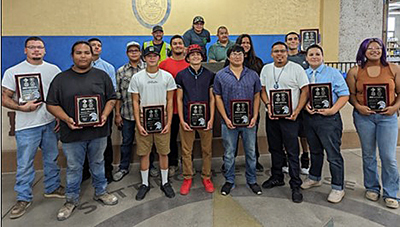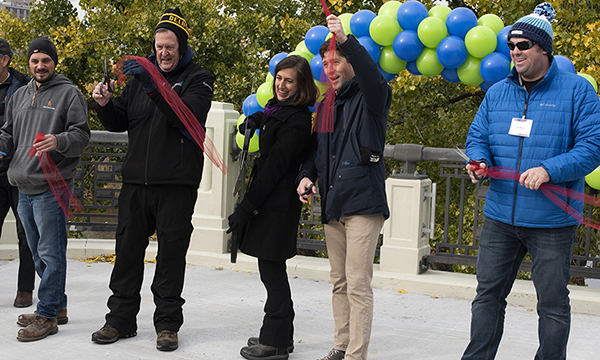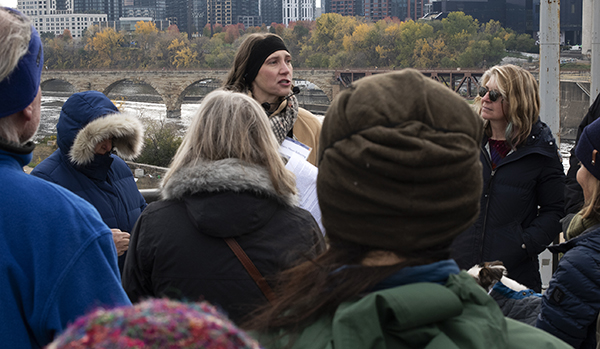 |
|

|
 |
TABLE of CONTENTS
 |
13 Indigenous students join the workforce as cement masons following MnDOT's rigorous 10-week program |
By Kevin Strus, Seeds Program student worker, Office of Civil Rights

A cement floor with Native design made entirely by participants in MnDOTís Cement Masons Tribal Training program. Photo by Adrienne Bond |
Each year, MnDOT sponsors a cement masons training program in collaboration with the federally recognized tribes in Minnesota. The 2023 program, which ran for 10 weeks and ended in August, included Indigenous students from Misi-zaaga'iganiing (Mille Lacs Band of Ojibwe), Gaa-zagaskwaajimekaag (Leech Lake Band of Ojibwe), Pezihutazizi Oyate (Upper Sioux Community) and Nah-gah-chi-wa-nong (Fond du Lac Band of Lake Superior Chippewa). Upon graduation, each student was offered a cement masonry apprenticeship position.
The participants were referred to the program by Tribal leaders, and 13 completed the rigorous curriculum, which included learning how to lay concrete and how to form curb and gutter.

MnDOT Cement Mason Tribal Training program graduates and lead instructors. Photo by Adrienne Bond |
The graduation ceremony offered students an opportunity to give speeches reflecting on their experiences. Many noted that the first week of the program had been especially challenging, highlighting the physical demands of cement masonry and the difficulties of working with a new team of people.
One graduate, Mercedes Doffing, spoke with admiration about lead instructor Marissa Goodsky, who had gone through the same program several years ago. “She always pushed you to your limit and when you needed help, she would help you,” Doffing said. “She’d always praise you when you did a good job and you’re doing your hard work.” Doffing also noted that, while cement masonry is a male-dominated field, there are opportunities for women, and she offered words of wisdom for any who wanted to follow her path: “Know your worth.”
A sense of camaraderie and community was consistent throughout the speeches, as graduates expressed gratitude, love and support for one another. Many likened their shared experiences during the program to becoming “like family.” |
| |
|

|
 |
TABLE of CONTENTS
 |
Snelling Ave. "road diet" project awarded $1 million grant |
| By Micaela Kranz, Research & Innovation
coordinator
In 2024, MnDOT crews will reconfigure Hwy 51/Snelling Ave. between Montreal Ave. and Ford Pkwy. in St. Paul to improve safety for all road users. This project is funded in part by a $1 million grant from the Federal Highway Administration’s Accelerated Innovation Deployment program.
This project will include several changes to the roadway, including reducing traffic to one lane in each direction, with dedicated left turns through a center median. The city will reconstruct the traffic signals at Montreal Ave. and Snelling Ave. and remove little-used parking along Snelling to add a new 10-foot multiuse trail on the east side of the street, consistent with St. Paul’s Bicycle Plan.
The process of converting a four-lane road to three lanes — two travel lanes with a turning lane and median in the middle — is called a “road diet” or 4-3 conversion, because of the reduction in lanes.
Road diets are a proven FHWA safety countermeasure, with benefits including:
- Reduction of rear-end and left-turn crashes due to the dedicated left-turn lane.
- Reduced right-angle crashes as motorists entering from side streets cross three lanes instead of four.
- Fewer lanes for pedestrians to cross.
- The opportunity to install pedestrian refuge islands, bicycle lanes, on-street parking, or transit stops.
- Traffic calming and more consistent speeds.
FHWA’s AID Program is designed to accelerate the implementation and adoption of innovation in highway transportation. There are 127 AID demonstration projects across the nation. MnDOT’s St. Paul project and its selection process could serve as a model for road diets elsewhere in the state, demonstrating a low-cost way to improve safety and quality of life. |
Not every four-lane road is a candidate for a road diet, but there are a variety of factors on this 0.4-mile stretch of Snelling Ave. that make it ideal for such a treatment. For example:
- Three-lane conversion studies have demonstrated a recommended upper limit of average daily traffic of 20,000 vehicles per day. Snelling Ave. carried only 13,100 vehicles per day, as of 2017.
- Existing parking in the area is underutilized at 1%. Reutilizing the space for amenities including a trail, upgraded sidewalk, planted boulevards and stormwater infiltration trenches can provide greater community benefit.
- A 2015-2019 crash analysis of this area resulted in a crash rate index above 1, illustrating the need to improve pedestrian safety. The road diet will reduce the distance pedestrians have to cross, minimize the threat of crashes, and calm traffic.
“While this isn’t Metro District’s first road diet on a trunk highway, it’s our first road diet driven primarily by safety improvements, rather than pavement preservation,” said Jesse Thornsen, MnDOT’s Metro District North Area Coordinator. “We’re hopeful this proven safety strategy will improve comfort for all road users in our St. Paul community.”
This video shows what will happen with the construction project on Hwy 51/Snelling Ave. between Montreal Ave. and Ford Pkwy. in St. Paul in 2024.
|
|
| |
|

|
 |
TABLE of CONTENTS
 |
Bob Bennett named new the chief business technology officer |
|
By Doug Mack
Bob Bennett has been named as MnDOT’s new chief business technology officer.
Bennett first worked for the agency as a student worker in 1989, and subsequently held various positions with the State of Minnesota, most recently as application operations director for the MNIT MnDOT team.
His career also includes time away from MnDOT, consulting for IT and engineering firms, and positions in the State of Minnesota Intertechnologies Group (the predecessor to MNIT).
Bennett’s past roles include business analyst, engineering systems support, network architect, systems programmer, and management.
|
| |
|

|
 |
TABLE of CONTENTS
 |
Fraud Awareness and Prevention Week highlights importance of employee efforts to keep agency safe |
By Jim Drake, Office of Audit

Each day during the week of Nov. 12-18 information will be shared on the Fraud Prevention webpage to help prevent fraud.
|
Gov. Tim Walz has proclaimed Nov. 12-18, 2023 to be Fraud Awareness and Prevention Week in Minnesota, an annual event that has been observed by MnDOT and the state government for 10 years. Commissioner Daubenberger and Deputy Commissioners Collins and Wallace have also added their endorsements.
Fraud Awareness and Prevention Week highlights various aspects of these essential topics.
As a reminder, fraud may include:
- Over-reporting expenses
- Underreporting assets or income
- Identity theft
- Online scams
- Overcharging
- Billing schemes
- Phishing
- Misuse of state assets.
Fraud, abuse, and waste may seem inevitable, but this is false – they can be prevented. Doing so is a team effort. Tips received from employees are consistently the greatest source of fraud detection, and increasing employee awareness of fraud and educating employees about fraud prevention, detection, and reporting techniques, is critical for reducing the incidence of fraud against and within Minnesota state government. In a 2022 survey of occupational fraud, the Association of Certified Fraud Examiners found that 42% of fraud cases were discovered from tips. That is three times more than the second most common.
There’s a reason MnDOT spends so much time on this topic, including in the yearly observation and as part of employees’ annual required training: it’s because fraud affects individuals, businesses, and government and the consequences can be devastating.
Consider a recent example. On Oct. 12, 2023, seventeen employees of the Broward County Sherriff’s Office were charged by the U.S. Attorney’s Office in Florida with trying to defraud the federal government of nearly $500,000 in Paycheck Protection Program loans. Broward County Sherriff Gregory Tony said his office’s public corruption unit received a tip from an employee that several other employees were taking part in the scheme.
In another example from Sept. 2023, hackers accessed Caesars Entertainment and MGM Resorts International computer systems. The fraudsters gained access to the businesses’ systems by impersonating an employee and tricking the IT service desk into resetting a password to install the hackers’ ransomware. The scheme ultimately cost Caesars $15 million in ransom and crippled MGM’s registration systems, keycard access and slot machine operations.
Even with seemingly strong controls in place, the failure of MGM and Caesars’ operation ultimately came down to lack of internal controls over passwords and human error.
These examples clearly show employees are the greatest resource in the fight against fraud.
That is why MnDOT Office of Audit encourages all MnDOT employees to take advantage of the training opportunities and information sessions offered during this tenth anniversary of Fraud Awareness and Prevention Week.
Visit Safeguarding MnDOT’s Fraud Prevention page for more information and resources in the fight against fraud. As always, you can report vulnerabilities, suspicious activities, and incidents through the Report Wrongdoing page.
|
| |
|

|
 |
TABLE of CONTENTS
 |
Reminder: Open enrollment period now underway |

Open Enrollment will run from Oct. 26 - Nov. 15.
|
By Doug Mack
Minnesota Management and Budget has launched the 2024 Open Enrollment website, which includes details on signing up for, changing or waiving benefits for 2024.
The open enrollment period began on Oct. 26 and will end on Nov. 15 at 11:59 p.m. The website includes 2024 premium rates, along with other information on employee benefits such as:
- Medical insurance
- Dental insurance
- Vision insurance
- Long-term Disability insurance
- Life insurance
- Manager's Income Protection Program
Pre-tax Expense Accounts |
| |
|

|
 |
TABLE of CONTENTS
 |
Technology Modernization Fund offers new IT project funding source |

The TMF program supports technological innovation. Photo by Sunan Wongsa-nga / Getty Images
|
By Danielle Jansen, Office of Administration
In 2023, the Minnesota Legislature provided $40 million of funding over four years for the Technology Modernization Fund. The TMF allows MNIT to fund small, quick projects and efforts that will modernize, secure and improve the customer experience of executive branch technology systems.
The TMF can be used to fund shovel ready projects, fund resources to expedite project work, fund a release or portion of a larger project, or for exploratory research. It is important that you can identify the specific value that the funds will deliver. The steering team is giving priority to shorter project work that will deliver a high value return.
If you have an IT Project that aligns with some of the criteria outlined below, submit your request to MNIT using the Technology Modernization Funding Request Form.
Project criteria for the TMF:
- Cost less than $1 million.
- Can be completed in less than one year.
- Improves the customer experience.
- Provides digital service delivery.
- Addresses a security risk.
- Modernizes a business process.
- Improves resiliency, operational efficiency and/or risk reduction.
- Aligns to the One Minnesota Plan.
- Moves to a shared or market-based technology solution.
- Leverages AI or automation.
Projects that are not a good fit for the TMF include:
- Maintenance and Support.
- Upgrading Desktops.
- Infrastructure.
- Implementing security software.
The MnDOT Technology Information Management Office will be working closely with MNIT on all requests submitted by DOT to the TMF to ensure timely project delivery and funding management. The initial submission is a short and will be reviewed within two weeks for initial idea acceptance.
If your idea is accepted, you will be required to submit additional project information including project plan, deliverables, value add, cost details and so on. For final funding approval, you will be required to present your project business case to the Modernization Steering Team. It can take up to six months from initial submission to funding if your project is approved. The Steering Team will monitor approved efforts to ensure performance targets are met. MnDOT TIM will coordinate efforts with MNIT and MnDOT business partners.
For additional information, questions, or assistance in completing a request, please contact the TIM office at tim.dot@state.mn.us or visit the MNIT Technology Modernization Fund Website.
|
| |
|

|
 |
TABLE of CONTENTS
 |
New internet resources now available |
By Julie Bartkey
There are a variety of new online resources pertaining to MnDOT’s sustainability efforts. Take a moment to visit the sites and add them to your bookmarks.
Minnesota Carbon Reduction Strategy
- Provides up-to-date information on the development of Minnesota’s first Carbon Reduction Strategy.
Minnesota Carbon Reduction Program
- Provides information about the FHWA-administered Carbon Reduction Program formula funds, including eligibility requirements and deadlines.
Minnesota PROECT Formula Program
- Provides information about what PROTECT (which stands for Promoting Resilient Operations for Transformative, Efficient, and Cost-Saving Transportation), including eligibility requirements and deadlines.
Minnesota Metropolitan Planning Organizations
- Provides information about all the aspects of a Metropolitan Planning Organization, where they are located, what they do and who they coordinate with, what is a MTP and why are MPOs integral to transportation in Minnesota.
Connected and Automated Vehicles
- Updated content on MnDOT’s CAV program
|
| |
|

|
 |
TABLE of CONTENTS
|
On the Job: Bryan Nagorka puts technology to good use |
|
By Rich Kemp
Bryan Nagorka is a scanning processor in the Metro District Surveys Office. He has been with MnDOT for 13 years.
When did you start at MnDOT and what positions have you held?
I started with MnDOT in 2010 as a student worker in Metro Surveys Construction. I worked my way up to a construction crew chief in 2016 before transitioning into my current role as the Metro District scanning processor in late 2021.
What are your day-to-day tasks?
I process the Lidar data that our field crews collect with our static scanners. I analyze the data and extract important features such as curb, sidewalk, signals, trees, signs, etc. I use those extracted features to produce 3D models and surfaces that provide the engineers and designers the information they need to make future road improvement designs.
What are the most challenging and rewarding parts of your job?
I find it rewarding to work with point clouds because of the amount of information they can provide. A point cloud is a digital 3D representation of a physical object or space. Each project has its different requests and challenges that always keep me refining my workflows and learning new tools within the software. Once the crews finish the 3D scans in the field, it comes back to the office, where a couple different coworkers use software to stitch all of the point clouds together. I am the final part of the entire process. I analyze and extract the data. I use TopoDOT (point cloud extraction software) to extract all the requested features from the point clouds (sidewalk, curb, road surface, bridge clearances, asset locations, etc.). I create the 3D model and surface from the extracted data that the designers will use when creating the design for future construction projects.
How has your job changed since you first started?
Most of my career at MnDOT has been in construction surveying. Our crew worked with the contractor to provide the staking so they could build the design. My current position focuses on the pre-design process. I help produce the deliverable that design will use to create the future road project design.
What are your interests or hobbies outside your work with MnDOT?
I enjoy spending time with my wife and two dogs around our property. If I am not in the vegetable garden, you will most likely find me out fishing or hunting.
Do you or a co-worker have an interesting job to share with readers? Send us your ideas, and we’ll contact you for more information.
Recent employee profiles:
|
 |
|

|
 |
TABLE of CONTENTS
|
Third Ave. Bridge reopens with ceremony and celebration |
By Doug Mack

The Third Ave. Bridge, which connects downtown Minneapolis with the Northeast part of the city, officially reopened with a community celebration on Oct. 28. The ribbon-cutting included, from left, John Schmitz from Ames Construction, Minneapolis City Councilmember Michael Rainville, Commissioner Nancy Daubenberger, Minneapolis Mayor Jacob Frey and MnDOT Senior Project Engineer Tim Nelson. Other highlights from the festivities included food trucks, a live band and (in the photo below) a history tour led by MnDOT Program Historian Katie Haun Schuring.Photos by Rich Kemp

|
|
 |
|

|
 |
TABLE of CONTENTS
|
Landscape architects speak about their time at MnDOT during the ASLA Conference |
By Rich Kemp

MnDOT landscape architects Carol Zoff, Ashley Zidon and Andrea Weber were part of a panel at the American Society of Landscape Architects Conference Oct. 28 at the Minneapolis Convention Center. They discussed their varied roles within the agency, their career paths, how and why they came to public practice, and the opportunities and benefits of working in the public sector. They also discussed how landscape architects are making themselves valued in a large, engineering-based organization. Nissa Tupper, Transportation and Public Health Planning director, was the moderator for the "Inside the LA-Studios" discussion. In the photo from the left are Carol Zoff, Nissa Tupper, Ashley Zidon and Andrea Weber. Submitted photo
|
|
 |
|

|
 |
TABLE of CONTENTS
|
Reminder: Veterans Employee Resource Group to host Veterans Day Lunch and Learn |
In recognition of Veterans Day, and to highlight some of the needs of current military members, MnDOT’s Veterans Employee Resource Group invites agency employees to participate in the group’s Veterans Day Lunch and Learn on Thursday, Nov. 9 from 12 p.m. to 1 p.m.
The event will feature a presentation by Troy T. Gjerde, soldier and family readiness specialist with the Minnesota Army National Guard, on the topic of “What National Guard and reserve members and their families may need before, during and after deployment.”
The Lunch and Learn will be held on Teams via this link.
To learn more about the Veterans Employee Resource Group, visit the group’s page on iHUB.
|
 |
|

|
 |
TABLE of CONTENTS
|
Name That Place Puzzler #12 |
By Doug Mack
Can you name the place pictured below? Traffic camera photo and satellite image are both from the 511 website and app.
If you think you know the answer, email Newsline editor Doug Mack. The first three people to submit the correct answer will receive the fame and glory of having their names listed in the next issue of Newsline.
Answer to the last Puzzler: Chisago Lake Cemetery in Center City. The first people to get it right Melissa Bartlett (Office of Maintenance), Patrick Gilbertson (Office of Land Management) and Kim Nye (Central Office). Congrats to them and thanks to everyone who played!
Special thanks to Bobbie Hamper (Central Office), who suggested this location. If you know a place that would make a good Puzzler, please get in touch!
|
 |
|
|
|



